Central Board of Secondary Education
The Central Board of Secondary Education (CBSE) is a national level board of education in India for public and private schools, controlled and managed by the Government of India. Established in 1929 by a resolution of the government, the Board was an experiment towards inter-state integration and cooperation in the sphere of secondary education. There are more than 27,000 schools in India and 240 schools in 28 foreign countries affiliated to the CBSE. All schools affiliated to CBSE follow the NCERT curriculum especially from class 9 to 12. The current Chairperson of CBSE is Nidhi Chhibber, IAS.[3]
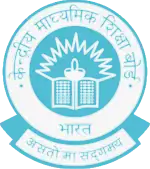 Seal of the Central Board of Secondary Education | |
| Abbreviation | CBSE |
|---|---|
| Formation | 2 July 1929 |
| Type | Governmental Board of Education |
| Legal status | Active |
| Headquarters | New Delhi, India |
Official language | |
Chairperson | Nidhi Chhibber, IAS[1] |
Parent organisation | Ministry of Education |
| Affiliations | 28,573 schools (29 April 2022)[2] |
| Website | www |
The constitution of the Board was amended in 1952 to give its present name, the Central Board of Secondary Education. The Board was reconstituted on 1 July 1962 so as to make its services available to students and various educational institutions in the entire country.[4]
History
The first education board to be set up in India was the Uttar Pradesh Board of High School and Intermediate Education in 1921, which was under jurisdiction of Rajputana, Central India and Gwalior. In 1929, the government of India set up a joint Board named Board of High School and Intermediate Education. This included Ajmer, Merwara, Central India, and Gwalior. Later it was confined to Ajmer, Bhopal and Vindhya Pradesh. In 1952, it became the Central Board of Secondary Education.[5]
Languages
CBSE offers academic subjects in 40 different languages, which are Arabic, Assamese, Bahasa Melayu, Bengali, Bhutia, Bodo, English, French, German, Gujarati, Gurung, Hindi Course-A, Hindi Course-B, Japanese, Kannada, Kashmiri, Lepcha, Limboo, Malayalam, Meitei (Manipuri), Marathi, Mizo, Nepali, Odia, Persian, Punjabi, Rai, Russian, Sanskrit, Sindhi, Spanish, Sherpa, Tamang, Tamil, Tangkhul, Telugu AP, Telugu Telangana, Thai, Tibetan, Urdu Course A and Urdu Course B.[6]
Affiliations
CBSE affiliates all Kendriya Vidyalayas, all Jawahar Navodaya Vidyalayas, private schools, and most of the schools approved by central government of India.All State Government schools in Delhi are affiliated with CBSE. There are 1,138 Kendriya Vidyalayas, 3,011 Government Schools, 16,741 Independent Schools, 595 Jawahar Novodaya Vidyalayas and 14 Central Tibetan Schools.[7]
Examinations
CBSE conducts the final examinations for Class 10 and Class 12 every year in the month of March. The results are announced by the end of May.[8] The board earlier conducted the AIEEE Examination for admission to undergraduate courses in engineering and architecture in colleges across India, however the AIEEE exam was merged with the IIT-Joint Entrance Exam (JEE) in 2013. The common examination is now called JEE (Main) and is henceforth conducted by National Testing Agency.
CBSE also conducted AIPMT (All India Pre Medical Test) for admission to major medical colleges in India. In 2014, the conduct of the National Eligibility Test for grant of junior research fellowship and eligibility for assistant professor in institutions of higher learning was outsourced to CBSE.[9]
Apart from these tests, CBSE also conducts the Central Teacher Eligibility Test and the Class X optional proficiency test.[9] With the addition of NET in 2014, the CBSE had become the largest exam conducting body in the world.[9][10]
On 10 November 2017, the Union Cabinet, chaired by Prime Minister Narendra Modi, cleared a proposal for creation of a National Testing Agency (NTA) serving as the premier autonomous body for conducting entrance examinations in the country. Beginning in 2018 various exams previously conducted by the CBSE were transferred to the NTA including National Eligibility cum Entrance Test (Undergraduate), Joint Entrance Examination – Main, National Eligibility Test, Central Universities Common Entrance Test and others.[11]
Promotion criteria
Class 10
For promotion from Secondary level (Class IX-X) to Senior Secondary level (Class XI-XII), a student must obtain, for all subjects (or best 5 if 6 subjects are taken), 33% overall, without any minimum theory mark requirement. Originally, the passing criteria was set such that a student had to get 33% in both the theory and practical components. However, an exemption was initially granted for students writing the exam in 2018 as they went through the old CCE system in the previous year.[12] However, CBSE later extended this relief for students writing the exam from 2019 and later as well.[13] Students who do not manage to pass up to two subjects can write the compartment in those subjects in July. Those who fail the compartment, or fail in three subjects or more, must rewrite all the subjects taken in the next year.
Class 12
For class 12 students the promotion criteria are 33% overall, with 33% in both theory and practical examinations (if applicable). Students who do not manage to pass in exactly one subject can write the compartment for that subject in July. Those who fail the compartment, or those who fail in two subjects or more, must rewrite all the subjects taken in the next year.
Grading
For the Class 10 and Class 12 exams, CBSE (along with the marks obtained) includes the positional grade obtained by the student, which is dependent on the average performance of the students in that subject. Consequently, the cutoffs required to obtain a particular grade vary every year.
| Grade | Criteria |
|---|---|
| A1 | Top 1/8 of passed students in that subject |
| A2 | Next 1/8 of passed students in that subject |
| B1 | Next 1/8 of passed students in that subject |
| B2 | Next 1/8 of passed students in that subject |
| C1 | Next 1/8 of passed students in that subject |
| C2 | Next 1/8 of passed students in that subject |
| D1 | Next 1/8 of passed students in that subject |
| D2 | Last 1/8 of passed students in that subject |
| E | Failed students (in either theory, practical or overall) |
The cutoffs required to obtain a particular grade in 2018 are listed below:[15]
| Grade | English Core | Mathematics | Chemistry | Physics | Biology | Biotechnology | Engineering Drawing | Computer Science | Economics | Accountancy | Business Studies | Informatics Practices | Multimedia/Web Tech | Psychology | Sociology |
|---|---|---|---|---|---|---|---|---|---|---|---|---|---|---|---|
| A1 | 89 | 95 | 91 | 90 | 90 | 95 | 98 | 93 | 92 | 84 | 93 | 94 | 95 | 87 | |
| A2 | 84 | 84 | 81 | 82 | 84 | 91 | 95 | 88 | 85 | 73 | 83 | 91 | 78 | ||
| B1 | 78 | 73 | 73 | 75 | 79 | 86 | 92 | 83 | 78 | 65 | 75 | 87 | 82 | 84 | 73 |
| B2 | 72 | 63 | 67 | 69 | 74 | 83 | 89 | 78 | 70 | 59 | 67 | 78 | 79 | 66 | |
| C1 | 65 | 55 | 63 | 64 | 68 | 76 | 85 | 72 | 63 | 55 | 60 | 79 | 74 | 73 | |
| C2 | 57 | 46 | 60 | 61 | 62 | 80 | 55 | 49 | 67 | 67 | |||||
| D1 | 45 | 42 | 52 | 54 | 55 | 47 | 45 | 57 | |||||||
| D2 | 33 | 33 | Variable (33% theory and practical pass required) | ||||||||||||
| Grade | English Language & Literature | Mathematics | Science | Social Science | Malayalam | Hindi | French |
|---|---|---|---|---|---|---|---|
| A1 | 92 | 92 | 87 | 90 | 96 | 93 | 97 |
| A2 | 87 | 81 | 76 | 82 | 93 | 88 | 95 |
| B1 | 83 | 70 | 67 | 74 | 90 | 83 | 92 |
| B2 | 78 | 60 | 58 | 66 | 87 | 78 | 87 |
| C1 | 73 | 50 | 49 | 58 | 84 | 72 | 82 |
| C2 | 66 | 42 | 41 | 49 | 80 | 65 | 74 |
| D1 | 56 | 34 | 34 | 41 | 73 | 54 | 62 |
| D2 | 33 (minimum for all subjects) | ||||||
During CCE
During 2010–2017, when CBSE implemented a CCE (Continuous and Comprehensive Evaluation) for Class X students, only the grades obtained by the student were mentioned in the report card in a 9-point grading scale, which translates as below:
| Grade | Criteria |
|---|---|
| A1 | >90% |
| A2 | 81–90% |
| B1 | 71–80% |
| B2 | 61–70% |
| C1 | 51–60% |
| C2 | 41–50% |
| D | 33–40% |
| E1 | 21–32% |
| E2 | 0–20% |
Results
2016
| CGPA | MALE | FEMALE | TOTAL |
| 10 | 85,316 | 83,225 | 1,68,541 |
| 9.8 | 26,313 | 24,545 | 50,858 |
| 9.6 | 28,522 | 24,223 | 52,745 |
| 9.4 | 35,587 | 25,882 | 61,469 |
| 9.2 | 33,674 | 25,171 | 58,845 |
| 9 | 35,167 | 26,270 | 61,437 |
| 8.8 | 36,453 | 26,154 | 62,607 |
| 8.6 | 37,532 | 25,945 | 63,477 |
| 8.4 | 38,590 | 25,383 | 63,973 |
| 8.2 | 37,681 | 24,663 | 62,344 |
| 8 | 38,248 | 24,217 | 62,465 |
| 7.8 | 38,560 | 23,607 | 62,167 |
| 7.6 | 37,804 | 22,680 | 60,484 |
| 7.4 | 36,814 | 21,410 | 58,224 |
| 7.2 | 35,287 | 20,497 | 55,784 |
| 7 | 34,755 | 19,803 | 54,558 |
| 6.8 | 33,824 | 18,677 | 52,501 |
| 6.6 | 32,099 | 17,559 | 49,658 |
| 6.4 | 29,774 | 16,428 | 46,202 |
| 6.2 | 27,367 | 15.509 | 42,876 |
| 6 | 25,542 | 14,472 | 40,014 |
| 5.8 | 22,568 | 13,094 | 35,662 |
| 5.6 | 18,126 | 11,128 | 29,254 |
| 5.4 | 13,206 | 8,684 | 21,890 |
| 5.2 | 9,120 | 6,142 | 15,262 |
| 5 | 6,116 | 4,036 | 10,152 |
| 4.8 | 3,582 | 2,360 | 5,942 |
| 4.6 | 2,074 | 1,182 | 3,256 |
| 4.4 | 893 | 527 | 1,420 |
| 4.2 | 294 | 151 | 445 |
| 4 | 50 | 31 | 81 |
| TOTAL | 8,40,938 | 5,73,655 | 14,14,593 |
| AVERAGE | 7.91 | 8.14 | 8.00 |
| CGPA | BOARD | SCHOOL | TOTAL |
| 10 | 92,816 | 75,725 | 1,68,541 |
| 9.8 | 32,372 | 18,486 | 50,858 |
| 9.6 | 32,115 | 20,630 | 52,745 |
| 9.4 | 32,302 | 29,167 | 61,469 |
| 9.2 | 33,725 | 25,120 | 58,845 |
| 9 | 36,361 | 25,076 | 61,437 |
| 8.8 | 36,673 | 25,934 | 62,607 |
| 8.6 | 36,026 | 27,451 | 63,477 |
| 8.4 | 35,232 | 28,741 | 63,973 |
| 8.2 | 35,362 | 26,982 | 62,344 |
| 8 | 35,185 | 27,280 | 62,465 |
| 7.8 | 33,969 | 28,198 | 62,167 |
| 7.6 | 31,825 | 28,659 | 60,484 |
| 7.4 | 29,836 | 28,388 | 58,224 |
| 7.2 | 28,045 | 27,739 | 55,784 |
| 7 | 26,238 | 28,320 | 54,558 |
| 6.8 | 23,913 | 28,588 | 52,501 |
| 6.6 | 21,284 | 28,374 | 49,658 |
| 6.4 | 18,782 | 27,420 | 46,202 |
| 6.2 | 16,785 | 26,091 | 42,876 |
| 6 | 14,365 | 25,649 | 40,014 |
| 5.8 | 12,150 | 23,512 | 35,662 |
| 5.6 | 9,351 | 19,903 | 29,254 |
| 5.4 | 6,861 | 15,029 | 21,890 |
| 5.2 | 4,978 | 10,284 | 15,262 |
| 5 | 3,628 | 6,524 | 10,152 |
| 4.8 | 2,278 | 3,664 | 5,942 |
| 4.6 | 1,236 | 2,020 | 3,256 |
| 4.4 | 549 | 871 | 1,420 |
| 4.2 | 137 | 308 | 445 |
| 4 | 17 | 64 | 81 |
| TOTAL | 7,24,396 | 6,90,197 | 14,14,593 |
| AVERAGE | 8.21 | 7.79 | 8.00 |
Moderation
- Mark distributions for each subject and overall average in CBSE Class 12 examinations 2015
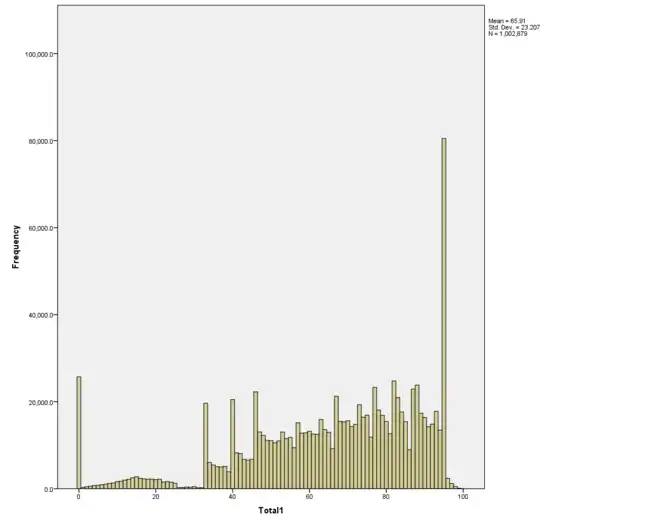 Subject 1 mark distribution. Note the unusual peak for 95, 33, and a few other marks and a sudden drop in frequency for 96 marks and above.
Subject 1 mark distribution. Note the unusual peak for 95, 33, and a few other marks and a sudden drop in frequency for 96 marks and above.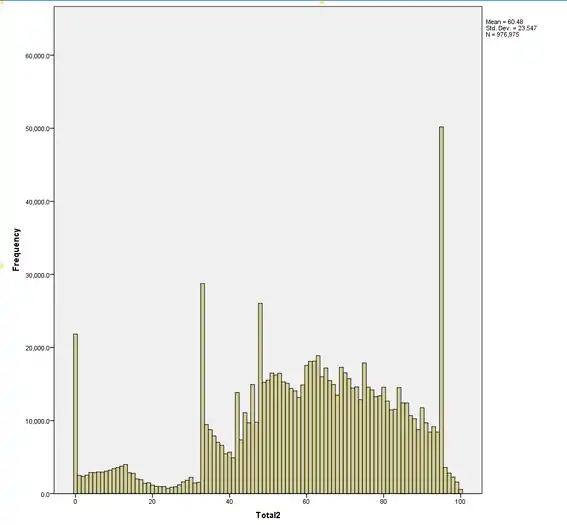 Subject 2 mark distribution. The peaks still stand.
Subject 2 mark distribution. The peaks still stand.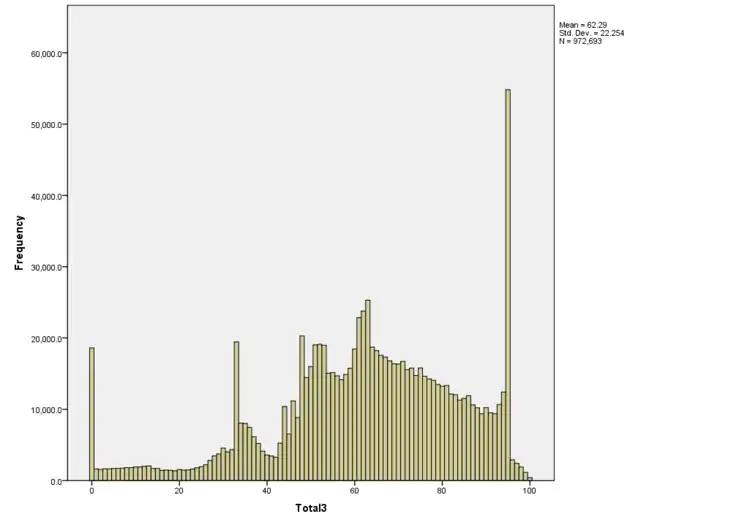 Subject 3 mark distribution. The peaks still stand, but there are fewer students scoring zero in the exam, which can be attributed to science students who skipped the theory exam having their practical mark alone taken.
Subject 3 mark distribution. The peaks still stand, but there are fewer students scoring zero in the exam, which can be attributed to science students who skipped the theory exam having their practical mark alone taken.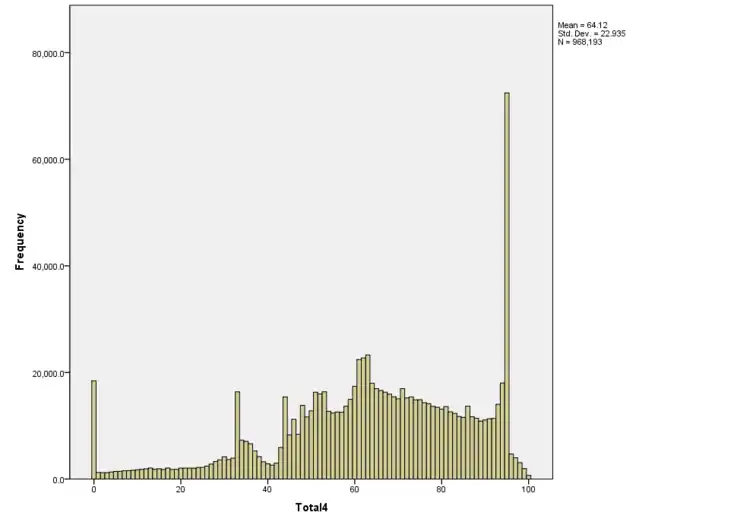 Subject 4 mark distribution. The peaks still stand.
Subject 4 mark distribution. The peaks still stand. Subject 5 mark distribution. The peaks still stand, through lower this time as subjects like Computer Science do not have any moderation applied.
Subject 5 mark distribution. The peaks still stand, through lower this time as subjects like Computer Science do not have any moderation applied.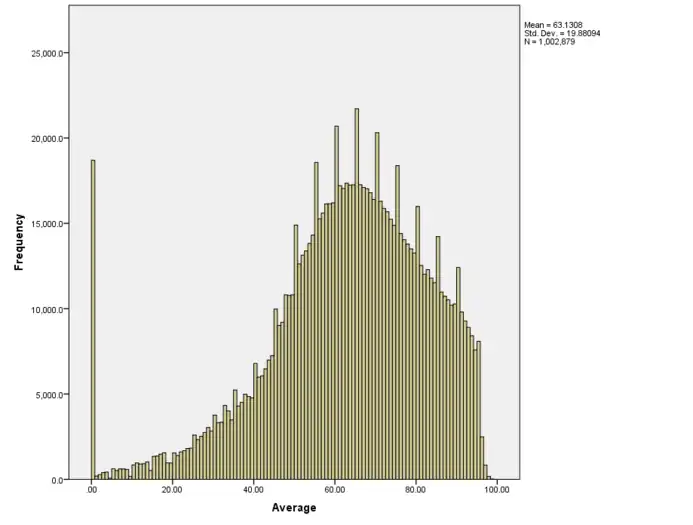 Overall average (first five subjects excluding any additional subjects if taken) for the same class and year. The peak on zero marks could mostly be attributed to students who did not show up for the exams at all. The distribution in this case is much more normal and symmetrical than the individual subjects' distribution.[17]
Overall average (first five subjects excluding any additional subjects if taken) for the same class and year. The peak on zero marks could mostly be attributed to students who did not show up for the exams at all. The distribution in this case is much more normal and symmetrical than the individual subjects' distribution.[17]
It is the practice adopted by CBSE of "tweaking" candidates' marks to account for paper difficulties and variations. This has been criticized in the past for inflating students' marks in a hyper-competitive society where even one mark counts,[18] and CBSE is in the process of ending it. In 2017, CBSE informed that it would end moderation entirely, but its decision was challenged by a court case at the Delhi High Court, which ruled that moderation should continue for that year.[19]
With the exception of 2018, moderation was applied to account for variations in region sets (as then students in different regions would be answering different question papers). In 2018, when everyone around the world answered the same questions,[20] this practice was renamed as standardisation, with the CBSE gradually phasing out the practice with the reduction on subjects which were given the offset.
In 2018, Mathematics, Physics, Chemistry and Accountancy were given offset of +9, Business Studies given +6, and English given a +3 offset. In 2019, moderation took the effect of giving up to 11 extra marks:[21]
| Subject | Offset (2019) | Offset (2018) | Offset (2017) | Offset (2016) |
|---|---|---|---|---|
| Mathematics | 11 | 9 | 10 | 15 |
| Physics | 11 | 9 | 9 | 8 |
| Chemistry | 10 | 9 | 9 | 7 |
| Biology | 5 | 0 | 3 | 0 |
| Political Science | 6 | 0 | 5 | 5 |
| Economics | 5 | 0 | 3 | 6 |
| Business Studies | 5 | 6 | 6 | 11 |
| Sociology | 2 | 0 | 0 | 6 |
| Geography | 1 | 0 | 0 | 8 |
The total mark obtained by a student through moderation cannot exceed 95; if so, it is capped at 95 unless the student's actual mark is 96 or more. This is the reason a mark of 95 is relatively common for such subjects, and why it is much tougher to get 96 than to get a 95.
Moderation was also applied in the infamous CBSE Class 12 mathematics papers of 2015 and 2016, wherein the paper created a huge furore as students and teachers complained that the paper was too tough.[22] Despite a reportedly heavy offset of +16 (+15 for Delhi),[23] students' marks reduced (especially for 2016), as while the A1 cutoff was stable (90), the A2 cutoff reduced to 77, with other grades also experiencing a dip in cutoff.
Moderation can also take the form of giving grace marks to enable students who have scored near the pass mark to pass. This is the reason marks between 25 and 33 are unheard of in subjects like Mathematics, and also explains why the difference between D1 and D2 cutoff is sometimes very small.
Changes for the 2019 exam
For the 2019 exam, CBSE decided that vocational exams (which very few students take) were to be held earlier – in mid/late February compared to March for most other exams. This was to ensure the exams finish earlier.[24][25]
For many core subjects, the number of internal choices (wherein students pick one to answer out of two) wereincreased.[26] The English (Core) paper of Class 12 was modified in a bid to make it less 'speedy'.[27]
Changes for 2020 exam
The Central Board of Secondary Education (CBSE) will now conduct two separate examinations for Mathematics in class 10 board examination starting from 2020 session. The current Mathematics exam is termed as Mathematics (Standard), and an easier version of Mathematics has been introduced, called as Mathematics (Basic). Students taking the latter version may not study Mathematics to any further level.
The option of choosing mathematics will be mentioned in the registration form for class 10 CBSE board examination. Candidates will be required to select their choice of test while filling the registration form for CBSE Class 10 board examination 2020.[28]
Minister of Education, MoE (previously Minister of Human Resource Department, HRD) amid the coronavirus outbreak had ordered rescheduling of pending examinations. The exams rescheduled were to be conducted between 1 and 15 July.[29][30] On 26 June, CBSE released as circular which cancelled the remaining exams and give scores based on the scores of the exams already taken by students. For some students of Delhi, who were able to give 3 or less exams were scored as per their performance in internal exams.[31] This decision came after a judicial ruling.[32]
Effect of COVID-19 pandemic on 2021 and 2022 exams
Due to rapid increase in COVID-19 cases in country, CBSE cancelled the board exams of 10th class & postponed the 12th class exams.[33]
Like 10th, Class 12th Board Exam 2021 has also been cancelled. Prime Minister Narendra Modi took a decision on this after a long meeting on 1 June 2021.[34][35]
Later, in a letter dated 5 July 2021, CBSE announced a special scheme of assessment for board examination of classes X and XII for the session 2021–22 in which the academic year was divided into 2 terms with approximately 50% syllabus in each term to increase the probability of boards being conducted by CBSE and to avoid depending on schools for declaring results.
The Term 1 examination was successfully conducted by CBSE in objective mode from 22 November to 12 December 2021 for Class 10 and from 16 November to 30 December 2021 for Class 12. However, the Term-I examination was criticised by many for having wrong answer keys, tough question papers and wrong or controversial questions with a question being dropped in Sociology exam of class 12 and a paragraph in English Language and Literature exam for class 10 by CBSE following which CBSE dropped the experts who set the Sociology and English paper from paper-setting panels.[36] The Term 2 examination were conducted from 26 April 2022 for both Class 10 and 12 and ended on 24 May for Class 10 and 15 June for Class 12.The results of Class 12 were declared on July 22, 2022, followed by the declaration of Class 10 results on the same day.
2018 question paper leak
In March 2018, there were reports that CBSE Class 10 mathematics and Class 12 economics question papers were leaked.[37] In response, CBSE announced that these exams will be cancelled and re-exams will be conducted.[37] However, CBSE later announced that there will be no re-exam for Class 10 mathematics paper because the paper leak may have been confined to a few alleged beneficiaries.[38]
On 7 April 2018, economics teacher Rakesh Kumar and two other employees of a private school in Una, Himachal Pradesh were arrested for leaking the Class 12 economics paper.[39] According to the police, Rakesh Kumar had gone inside the strong room of a bank to pick up packets of computer science question papers but also picked up a packet of economics question paper.[39] He asked a student to make a handwritten copy of the question paper (to avoid being traced from the handwriting).[39] He then sent photos of the handwritten copy of the paper on WhatsApp to a relative in Punjab.[39] This relative shared the photos with her son and nephew, who shared them with their friends on WhatsApp groups, from where it was forwarded to other WhatsApp groups.[39] On 12 April 2018, the police said that Rakesh Kumar, who leaked the class 12 economics paper, had leaked class 10 mathematics paper also.[40] Consequently, the Central Board of Secondary Education has put in place a system of "encrypted" question papers, which are supposed to be printed by the schools half an hour before the exam starts.[41]
Regional offices
| Regional Office | States/UT's/Areas covered |
|---|---|
| Ajmer | Gujarat and Rajasthan |
| Bengaluru | Karnataka |
| Bhopal | Madhya Pradesh |
| Bhubaneswar | West Bengal, Odisha and Chhattisgarh |
| Chandigarh | Chandigarh, Punjab, Jammu and Kashmir and Ladakh |
| Chennai | Andaman & Nicobar Islands, Puducherry and Tamil Nadu |
| Dehradun | Uttarakhand and few districts of Uttar Pradesh (Badaun, Bijnour, J.P.Nagar/ Amroha, Moradabad, Muzaffarnagar, Rampur, Saharanpur and Sambhal) |
| Delhi East | East Delhi, South East Delhi, South Delhi, South West Delhi, New Delhi and Shahdara districts of Delhi, and foreign schools |
| Delhi West | West Delhi, North West Delhi, North Delhi, North East Delhi and Central Delhi districts of Delhi |
| Guwahati | Assam, Nagaland, Manipur, Meghalaya, Tripura, Sikkim, Arunachal Pradesh and Mizoram |
| Noida | Agra, Aligarh, Baghpat, Bareilly, Bulandshahar, Etah, Firojabad, Gautam Budh Nagar, Ghaziabad, Hapur, Hathras, Kasganj / Kashi Ram Nagar, Mainpuri, Mathura, Meerut, Pilibhit, Shahjahanpur and Shamli districts of Uttar Pradesh |
| Panchkula | Haryana and Himachal Pradesh |
| Patna | Bihar and Jharkhand |
| Prayagraj | Ambedkar Nagar, Amethi, Auraiya, Ayodhya, Azamgarh, Bahraich, Ballia, Balrampur, Banda, Barabanki, Basti, Bhadohi, Chandauli, Chitrkoot, Deoria, Etawah, Farukkhabad, Fatehpur, Ghazipur, Gonda, Gorakhpur, Hamirpur, Hardoi, Jalaun, Jaunpur, Jhanshi, Kannauj, Kanpur Dehat, Kanpur Nagar, Kaushambi, Kushi Nagar, Lakhimpur Kheri, Lalitpur, Lucknow, Maharajganj, Mahoba, Mau, Mirjapur, Pratapgarh, Prayagraj, RaiBareilly, Sant Kabir Nagar, Shrabasti, Siddharth Nagar, Sitapur, Sonbhadra, Sultanpur, Unnao and Varanasi districts of Uttar Pradesh |
| Pune | Maharashtra, Goa and Dadra and Nagar Haveli and Daman and Diu |
| Thiruvananthapuram | Kerala and Lakshadweep |
| Vijayawada | Andhra Pradesh and Telangana |
Foreign schools
According to the official website of CBSE, there are 28 government as well as private affiliated schools in different countries outside India. The reason of their establishment is largely serving the Indian community abroad, or at least, children or relative of Indian diplomats.
For countries where the population of Indian nationals even surpasses the country's native population or in countries where they form a substantial share of the population, like Saudi Arabia, the United Arab Emirates, Oman, Qatar, Bahrain, etc., Indian embassies have set up CBSE schools and have allowed Indians or locals to set up private CBSE schools serving the needs of Indians in that particular country.
But, however, in countries where Indians do not reside, the Indian diplomatic missions have set up schools in countries like Russia and Iran which mainly serves children of diplomats.
See also
- CBSE expression series – an essay/painting competition aimed to make students aware of the history of women and men who have served the nation of India
- Council for the Indian School Certificate Examinations (CISCE)
- National Institute of Open Schooling (NIOS)
- Secondary School Leaving Certificate (SSLC)
- Junior Science Talent Search Examination
- Uttarakhand Board of School Education(UBSE)
- Delhi Board of School Education (DBSE)
References
- "Nidhi Chibber appointed CBSE chairperson". ThePrint. 13 May 2022. Retrieved 28 June 2022.
- "CBSE - Central Board of Secondary Education".
- "Senior IAS officer Nidhi Chibber appointed CBSE chairperson". Jagran English. 13 May 2022. Retrieved 15 May 2022.
- "CBSE - Central Board of Secondary Education".
- "History (and the Expansion) of the Central Board of Secondary Examination". studypost.com. 16 December 2017. Retrieved 16 December 2017.
- "CBSE | Academics Unit : Curriculum/Syllabus". cbseacademic.nic.in. Retrieved 18 March 2023.
- "CBSE introduction".
- "CBSE Results Announcement Dates: Class 12 on May 25, Class 10 on May 27". news.biharprabha.com. 23 May 2015. Retrieved 23 May 2015.
- "After UGC's failure, CBSE to conduct NET". The Times of India. 24 July 2014. Retrieved 24 July 2014.
- Joshua, Anita (23 July 2014). "NET to be held under CBSE's watch". The Hindu. Retrieved 24 July 2014.
- "National Testing Agency". www.nta.ac.in. Retrieved 7 June 2020.
- "CBSE says overall 33% marks enough to pass Class 10 this year". hindustantimes.com. 27 February 2018. Retrieved 25 August 2018.
- "CBSE Eases Class 10 Passing Marks Criteria as Combined Marks Extended from 2019 Board Exams". News18. Retrieved 21 October 2018.
- "Grading info" (PDF). cbseacademic.nic.in.
- Not publicly released by CBSE, but can be verified by looking at students' grades
- "Press Note for Class 10" (PDF). CBSE. Retrieved 13 May 2019.
- For the given dataset, if students took improvement exams (i.e, rewrote them) and hence wrote fewer than five subjects, the average of those subjects alone were taken. In all other cases like absenteeism in an exam for which the student has been registered for, a score is 0 is taken in this case. This means that it is not possible to distinguish from the graph - though it is from the dataset - whether a student actually scored zero or did not show up for the exam itself.
- "CBSE Result 2018: The Curious Case of 'Magic Mark 95'". 27 May 2018.
- "CBSE moderation row: Board awarded up to 11 extra marks in this year's Class 12th exams – Firstpost". firstpost.com. 2 June 2017.
- This article shows evidence that CBSE reverted to the past practice in 2019: Chakrabarty, Roshni (7 March 2019). "CBSE Class 10 Mathematics paper analysis: Board examiner says moderate paper, check student reactions and full question paper." IndiaToday.in. Retrieved 12 August 2019.
- 5; if so, it is capped at 95 unless the student's actual mark is 96 or more. This is the reason a mark of 95 is relatively common for such subjects, and why it is much tougher to get 96 than to get a 95.
- "A CBSE Math Paper So Tough, It Made Students Cry". 16 March 2016.
- "With no more 'marks moderation', CBSE Class XII results likely to dip; will bring down DU cutoffs". 18 May 2017.
- "CBSE 10th, 12th board exams 2019 date sheet released, check it now". Hindustan Times. 23 December 2018. Retrieved 17 January 2019.
- "Info" (PDF). cbseacademic.nic.in. 2018.
- "Info" (PDF). cbseacademic.nic.in. 2018.
- "Notification" (PDF). cbseacademic.nic.in. 2018.
- Team, BS Web (10 August 2019). "CBSE Class 10 exam 2020: 2 separate examinations to be held for mathematics". Business Standard India.
- "CBSE Board Exams Postponed Over Coronavirus Outbreak". NDTV.com. Retrieved 19 March 2020.
- "CBSE Board Class 10, 12 Exam Date Sheet 2020 HIGHLIGHTS: 'Step is inappropriate', parents oppose move". The Indian Express. 19 May 2020. Retrieved 7 June 2020.
- Bharadwaj, Dr Shayam (25 June 2020). "CBSE/CE/SPS/2020" (PDF). CBSE. CBSE. Retrieved 26 June 2020.
- "सीबीएसई 10वीं-12वीं के जुलाई में होने वाले एग्जाम रद्द होंगे, जानिए अब स्टूडेंट्स के पास क्या हैं विकल्प". News18 India. Retrieved 26 June 2020.
- "CBSE Board Exams 2021: Class 10 exams cancelled, Class 12 postponed". Hindustan Times. 14 April 2021. Retrieved 18 April 2021.
- "Covid-19: Centre cancels CBSE Class 12 exams, CISCE follows suit - Times of India". The Times of India. 2 June 2021. Retrieved 2 June 2021.
- "12th Board Exam 2021 LIVE Updates: CBSE, ISC 12th Exam Cancelled; Assessment Criteria Soon". NDTV.com. Retrieved 2 June 2021.
- "CBSE drops experts who set Sociology, English paper". The Indian Express. 22 January 2022. Retrieved 22 January 2022.
- "CBSE paper leak: Board announces re-exam; HRD initiates probe". The Economic Times. Press Trust of India. 28 March 2018. Archived from the original on 30 March 2018. Retrieved 31 March 2018.
- Shihabudeen Kunju S (3 April 2018). "No Re-Exam For Class 10 Maths Paper: CBSE". NDTV. Archived from the original on 4 April 2018. Retrieved 8 April 2018.
- Sikdar, Shubhomoy (8 April 2018). "How a Punjab housewife led Delhi cops to source of CBSE Economics paper leak". Hindustan Times. Archived from the original on 8 April 2018. Retrieved 8 April 2018.
- "Una teacher leaked both CBSE economics and maths question papers: Police". Business Standard. Press Trust of India. 12 April 2018. Archived from the original on 12 April 2018. Retrieved 12 April 2018.
- "Contacts". CBSE. Archived from the original on 12 June 2007. Retrieved 3 December 2016.
- "Contact Us". Central Board of Secondary Education. Retrieved 21 March 2021.